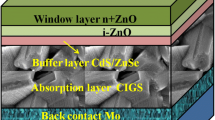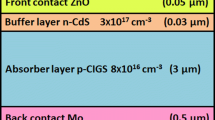Abstract
In this paper, two types of single absorber layer solar cells, Mo/p-CIS/n-CdS/Al-ZnO and Mo/p-CISSe/n-CdS/Al-ZnO, are simulated using the solar cell simulation software (SCAPS-1D), and the effect of the thickness of the absorber layer on the photovoltaic performance of the solar cells is investigated. In addition, the total thickness of the CIS/CISSe gradient bandgap absorber layer was specified to be 2.5 μm in the SCAPS-1D simulations, and the structure of the gradient bandgap solar cell was composed of Mo/p-CISSe/p-CIS/n-CdS/Al-ZnO. Using CdS and SnS2 buffer layers, respectively, the optimal photoelectric conversion efficiency (η) of the CIS/CISSe gradient bandgap solar cell is 23.23% and 23.52% at a CIS/CISSe layer thickness ratio of 1 μm/1.5 μm, which means that SnS2 can be used as a buffer layer for Cd-free solar cells. With the increase in carrier concentration in the buffer layer, the carrier transport mechanism changes from a leakage current mechanism to tunneling current mechanism. As a result, optimal open-circuit voltage (Voc), short circuit current (Jsc), filling factor (FF), and η of Mo/p-CISSe/ p-CIS /n-SnS2/Al-ZnO solar cell are 0.7809 V, 35.31 mA/cm2, 85.29%, and 23.52%, respectively, which uses the best impact parameters including CIS/CISSe absorption layer thickness ratio of 1 μm/1.5 μm, working temperature 300 K, and the carrier concentration of 1E + 18 cm−3.






Similar content being viewed by others
Data availability
The data supporting the findings of this study are available in the article.
References
Diaz-Loera A, Ramos-Serrano JR, Calixto ME (2022) Semiconducting CuIn(SX, Se1−X)2 thin-film solar cell modeling using SCAPS-1D. MRS Advances 7:28–32. https://doi.org/10.1557/s43580-022-00231-4
Ghebouli MA, Ghebouli B, Larbi R, Chihi T, Fatmi M (2021) Effect of buffer nature, absorber layer thickness and temperature on the performance of CISSe based solar cells, Using SCAPS-1D simulation program. Optik 241:166203. https://doi.org/10.1016/j.ijleo.2020.166203
Elfarri H, Bouachri M, Frimane A, Fahoume M, Daoudi O, Battas M (2021) Optimization of vermin of thickness layers, temperature and defect density of CIS based solar cells with SCAPS-1D software, for photovoltaic application. Chalcogenide Lett 18(4):201–213. https://doi.org/10.15251/CL.2021.184.201
Madan J, Shivani R, Pandey RS (2020) Device simulation of 17.3% efficient lead-free all-perovskite tandem solar cell. Solar Energy 197:212–221. https://doi.org/10.1016/j.solener.2020.01.006
Kim K, Gwak J (2017) Seung Kyu Ahn, Young-Joo Eo, Joo Hyung Park, Jun-Sik Cho, Min Gu Kang, Hee-Eun Song, Jae Ho Yun, Simulations of chalcopyrite/c-Si tandem cells using SCAPS-1D. Sol Energy 145:52–58. https://doi.org/10.1016/j.solener.2017.01.031
Abderrezek M, Djeghlal ME (2021) Numerical study of CZTS/CZTSSe tandem thin film solar cell using SCAPS-1D. Optik-Int J Light Electron Optics 242:167320. https://doi.org/10.1016/j.ijleo.2021.167320
Amiri S, Dehghani S (2020) Design of highly efficient CZTS/CZTSe tandem solar cells. J Electron. J Electron Mater 49:2164–2172. https://doi.org/10.1007/s11664-019-07898-w
Gupta GK, Dixit A (2018) Theoretical studies of single and tandem Cu2ZnSn(S/Se)4 junction solar cells for enhanced efficiency. Optic Mater 82:11–20. https://doi.org/10.1016/j.optmat.2018.05.030
Adewoyin AD, Olopade MA, Oyebola OO, Chendo MA (2019) Development of CZTGS/CZTS tandem thin film solar cell using SCAPS-1D. Optik 176:132–142. https://doi.org/10.1016/j.ijleo.2018.09.033
Muhunthan N, Singh OP, Thakur MK, Karthikeyan P, Singh D, Saravanan M, Singh VN (2014) Interfacial properties of CZTS thin film solar. Solar Energy 2014:476123. https://doi.org/10.1155/2014/476123
Boulkaddat L, Soussi A, Najih H, Abouabassi K, Ait hssi A, Labchir N, Elfanaoui A, Markazi R, Bouabid K, Ihlal A (2023) Experimental and theoretical study of electrodeposited CuInS2 thin films for solar cell applications. Phys B: Condens Matter 671:0921–4526. https://doi.org/10.1016/j.physb.2023.415374
Pervaiz H, Khan ZS, Shahzad N, Ahmed N, Jamil Q (2022) Synthesis and characterization of CuInS2 nanostructures and their role in solar cell applications. Mater Chem Phys 290:0254–0584. https://doi.org/10.1016/j.matchemphys.2022.126602
Moujoud S, Hartiti B, Touhtouh S, Rachidy C, Belhora F, Thevenin P, Hajjaji A (2021) Numerical modeling of copper indium disulfide thin film based solar cells. Optic Mater 122:111749 https://doi.org/10.1016/j.optmat.2021.111749
Siemer K, Klaer Jo, Luck I, Bruns J, Klenk R, Bräunig D (2001) Efficient CuInS2 solar cells from a rapid thermal process (RTP). Sol Energy Mater Sol Cells 67:159–166. https://doi.org/10.1016/S0927-0248(00)00276-2
Oyola JS, Castro JM, Gordillo G (2012) ZnO films grown using a novel procedure based on the reactive evaporation method. Sol Energy Mater Sol Cells 102:0927–248. https://doi.org/10.1016/j.solmat.2012.03.011
Ohashi T, Inakoshi K, Hashimoto Y, Ito K (1998) Preparation of Culn(SxSe1−x)2 thin films by sulfurization and selenization. Sol Energy Mater Sol Cells 50:0927–248. https://doi.org/10.1016/S0927-0248(97)00111-6
Ren G, Zhuang D, Zhao M, Wei Y, Wu Y, Li X, Lyu X, Wang C, Li Y (2020) CZTSSe solar cell with an efficiency of 10.19% based on absorbers with homogeneous composition and structure using a novel two-step annealing process. Solar Energy 207:651–658. https://doi.org/10.1016/j.solener.2020.07.016
Chen Z, Liu X, Zhao Y, Liang X, Chen Y, Wang L, Shen Y (2018) The study of the CdS film and the carrier transport characteristics of CdS/CuInS2 pn junction. J Sol-Gel Sci Technol 85:12–22. https://doi.org/10.1007/s10971-017-4525-6
Saraswathi Chirakkara SB (2012) Krupanidhi, Study of n-ZnO/p-Si (100) thin film heterojunctions by pulsed laser deposition without buffer layer. Thin Solid Films 520:5894–5899. https://doi.org/10.1016/j.tsf.2012.05.003
Pietruszka R, Luka G, Kopalko K, Zielony E, Bieganski P, Placzek-Popko E, Godlewski M (2014) Photovoltaic and photoelectrical response of n-ZnO/p-Si heterostructures with ZnO films grown by an Atomic Layer Deposition method. Mater Sci Semicond Process 25:190–196. https://doi.org/10.1016/j.mssp.2013.11.026
Nguyen M, Ernits K, Tai KF, Ng CF, Pramana SS, Sasangka WA, Batabyal SK, Holopainen T, Meissner D, Neisser A, Woong LH (2015) ZnS Buffer Layer for Cu2ZnSn(SSe)4 Monograin Layer Solar Cell. Sol Energy 111:344–349. https://doi.org/10.1016/j.solener.2014.11.006
Ullah S, Bouich A, Ullah H, Mari B, Mollar M (2020) Comparative study of binary cadmium sulfide (CdS) and tin disulfide (SnS2) thin buffer layers. Solar Energy 208:637–642. https://doi.org/10.1016/j.solener.2020.08.036
Tripathi S, Kumar B, Dwivedi DK (2021) Numerical simulation of non-toxic In2S3/SnS2 buffer layer to enhance CZTS solar cells efficiency by optimizing device parameters. Optik-Int J Light Electron Optic 227:166087. https://doi.org/10.1016/j.ijleo.2020.166087
Haghighi M, Minbashi M, Taghavinia N, Kim DH, Mahdavi SM, Kordbacheh AA (2018) A modelling study on utilizing SnS2 as the buffer layer of CZT(SSe) solar cells. Sol Energy 167:165–171. https://doi.org/10.1016/j.solener.2018.04.010
Kumagai Y, Burton LA, Walsh A, Oba F (2016) Electronic structure and defect physics of tin sulfides: SnS, Sn2S3, and SnS2. Phys Rev Appl 6:014009. https://doi.org/10.1103/PhysRevApplied.6.014009
Ghamsari-Yazdel F, Fattah A (2022) Performance enhancement of CIGS solar cells using ITO as buffer layer. Micro and Nanostructures 168:207289. https://doi.org/10.1016/j.micrna.2022.207289
Acknowledgements
The authors thank Dr Jianguo Fan from II–VI Inc. 141 Mt. Bethel Rd, Warren NJ 07059, for the help on correction of grammatical errors.
Funding
None.
Author information
Authors and Affiliations
Corresponding author
Ethics declarations
Conflict of interest
The authors declare no competing interests.
Additional information
Publisher's Note
Springer Nature remains neutral with regard to jurisdictional claims in published maps and institutional affiliations.
Rights and permissions
Springer Nature or its licensor (e.g. a society or other partner) holds exclusive rights to this article under a publishing agreement with the author(s) or other rightsholder(s); author self-archiving of the accepted manuscript version of this article is solely governed by the terms of such publishing agreement and applicable law.
About this article
Cite this article
Zhang, F., Yu, Q., Zhao, Hw. et al. The numerical simulation of CIS/CISSe graded band gap solar cell using SCAPS-1D software. J Nanopart Res 25, 256 (2023). https://doi.org/10.1007/s11051-023-05906-z
Received:
Accepted:
Published:
DOI: https://doi.org/10.1007/s11051-023-05906-z




